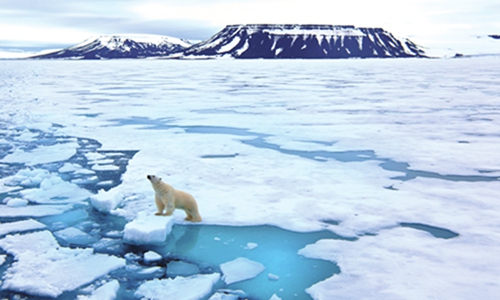
Photo:VCG
The Polar Silk Road has recently gained renewed attention following its rapid growth in supporting regional economy and securing energy supplies amid volatility throughout global supply chains posed by an ongoing pandemic in many parts of the world.
During the recent 2021 Arctic Circle Assembly hosted in Iceland, the Polar Silk Road, proposed by leaders of China and Russia in 2017, came under the spotlight as the melting of Arctic sea ice has made it possible for merchant ships to navigate the Arctic Ocean, greatly shortening shipping lanes connecting Asia and Europe and even North America.
Participants at the assembly said opening the Arctic route will promote the overall growth of the economy in the region and the global trade and shipping pattern will undergo major changes. Experts said that the Polar Silk Road will be an important direction for exploration as part of the Belt and Road Initiative (BRI).
The Polar Silk Road is a relatively new concept that has provided an alternative for global shipping companies, especially after the unprecedented chaos seen in the Suez Canal caused by a stranded cargo ship and global logistic hurdles posed by port congestion, Song Kui, the president of the Contemporary China-Russia Regional Economy Research Institute, told the Global Times on Thursday.
Under normal circumstances, the East Asia-Europe route needs to pass through the Suez Canal and the Strait of Malacca, a significant detour. But taking the route from Shanghai to Murmansk in Russia, means by crossing the Arctic waterway, the total voyage can be shortened by nearly half compared with traditional routes, taking about 15 days less time, and save 20 percent of fuel, Wu Minghua, a veteran industry analyst, told the Global Times.
The cargo shipping route across the Artic has been there for some years, the expert said. Most of the goods delivered via the routes are bulk commodities such as steel with ships that are designed or equipped specially for the regional environment.
Unlike traditional routes, due to harsh conditions in the Arctic, the route is seasonal - the best shipping period in a year is the summer time between July to September, said Wu, noting that if a trend of melting ice flows continues, the available shipping window would be further extended.
When the tightened energy supplies in many parts of the world, how to make the best and efficient transportation and exploitation of energy in the region has become more important than ever.
Between 2019 to 2021, the global demand for liquefied natural gas has increased substantially, with Asia and Europe accounting for 88 percent.
The corresponding projects, under the joint efforts of China and Russia, along the routes expected to help alleviate the energy tension.
One good example is Yamal LNG Project located in the Arctic Circle. In 2021, Yamal's LNG transportation volume will become the largest in the northern waterway, according to media reports.
Other example is Russia's Kamchatka Peninsula LNG station. Once completed, the project is expected to extend the transport of LNG in Russia to Asia.
While there are huge economic and trade opportunities still to be explored, challenges remain.
"These latest progress in the region are the important elements that paving the way for the future joint exploitation of the Polar Silk Road," Zhang Jianping, the director of the Center for regional Economy, Chinese Academy of International Trade and Economic Cooperation, told the Global Times on Thursday.
"But as a fairly new thing, substantive outcome might not be seen in short term," given the limited shipping period, tough natural environment and high requirements for shipping and exploitation amongst other factors, experts said.




